Scale Lane Bridge by McDowell+Benedetti
This apostrophe-shaped bridge in Hull, England, by London architects McDowell+Benedetti features a rotating mechanism so it can swing open to make room for passing boats (+ slideshow).
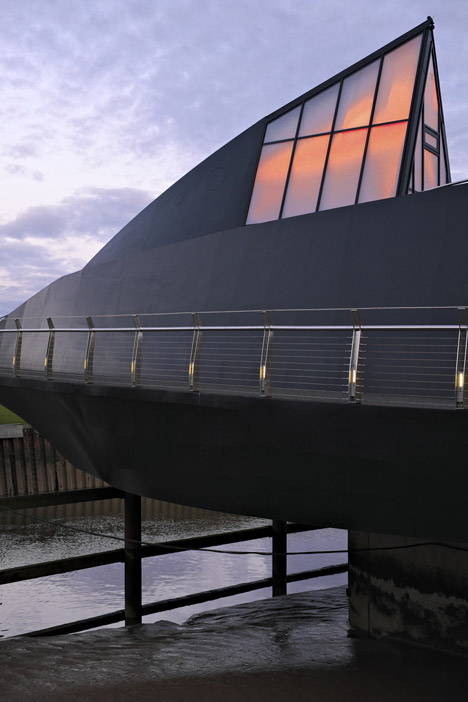
Scale Lane Bridge spans the river between Hull's Old Town and the as-yet undeveloped industrial land on the east bank, creating a pedestrian route between the city's museums and aquarium.
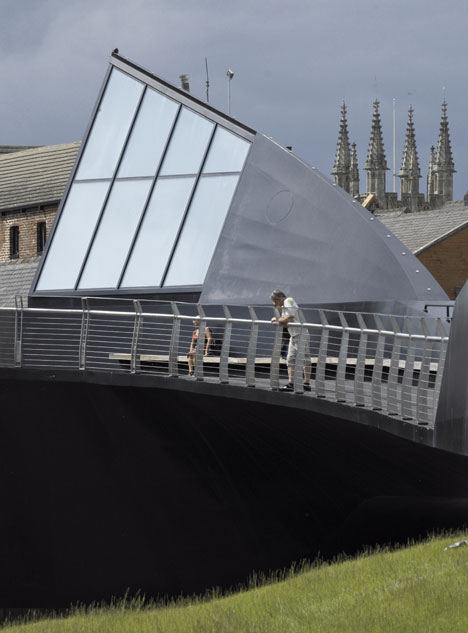
Working alongside engineers Alan Baxter Associates and Qualter Hall, McDowell+Benedetti designed the steel bridge with a slow movement so that pedestrians can continue to step on and off even when the structure is in motion.
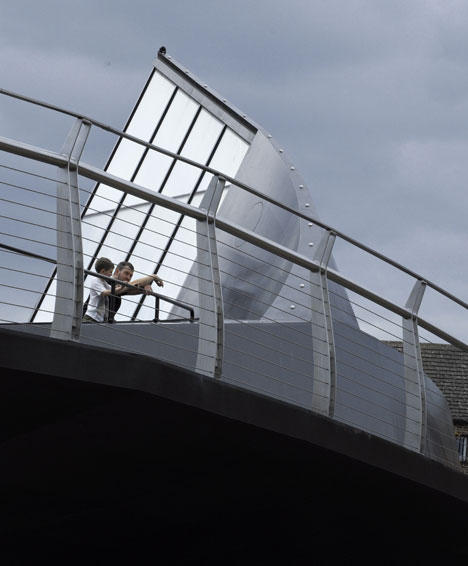
The apostrophe shape creates two different routes across the bridge. The first is a gentle slope that stretches along the outer edge, while the second is a stepped pathway that runs along the inside.

A raised spine separates the two routes, creating a seating area overlooking the water as well as a lighting feature that points upwards like the fin of a giant shark.
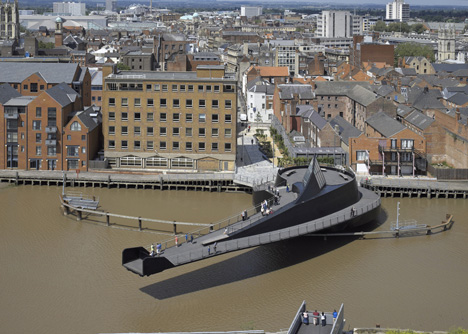
The centre of rotation is a single-storey drum, with a restaurant inside and a viewing platform on the roof.
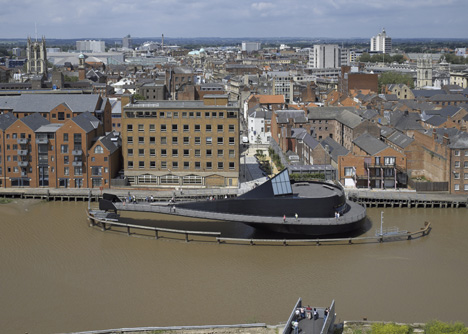
"The black steel bridge has a distinctive robust character and curving form, making it a memorable landmark that is unique to Hull and its industrial and maritime heritage," said the design team.
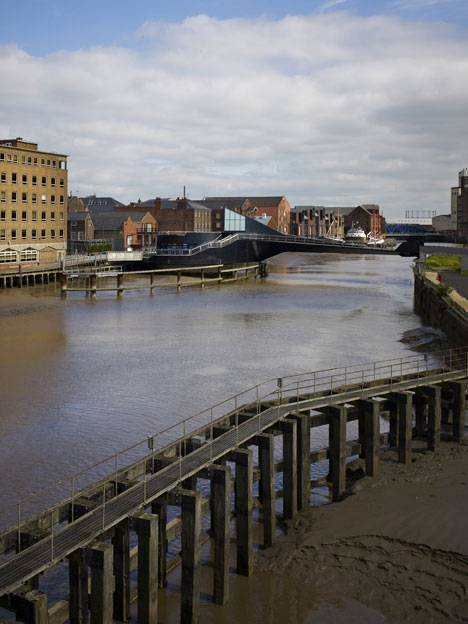
The underside of the bridge is tapered upwards to allow smaller vessels to pass through without opening the bridge.
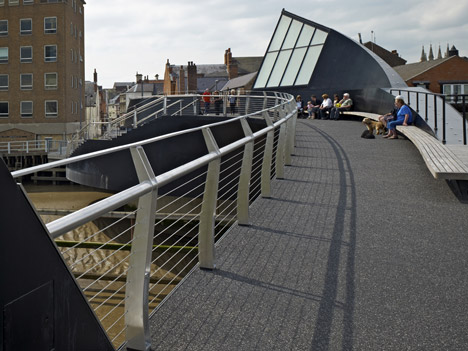
An installation by artist Nayan Kulkarni is also included, involving ringing bells and a pulsing light that are activated when the bridge starts to move.
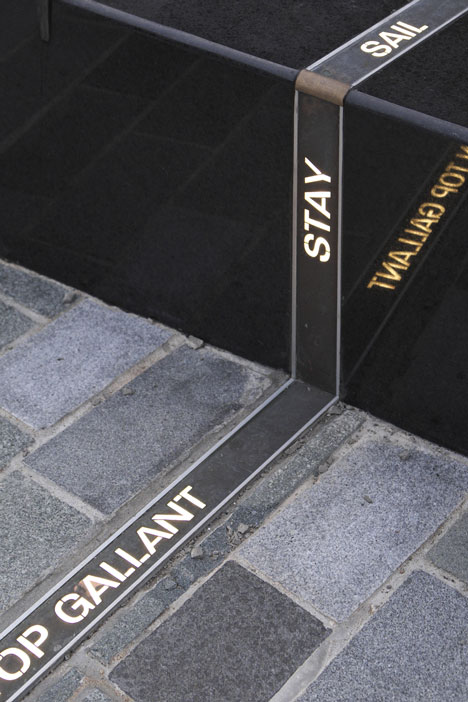
"This has a practical purpose in alerting pedestrians to the imminent opening rotation and it heightens the drama of the ride," added the designers.
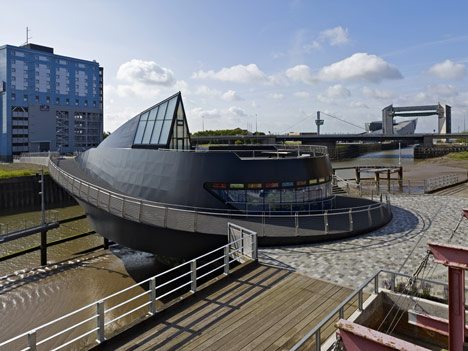
Low-level lighting illuminates the walkways after dark.
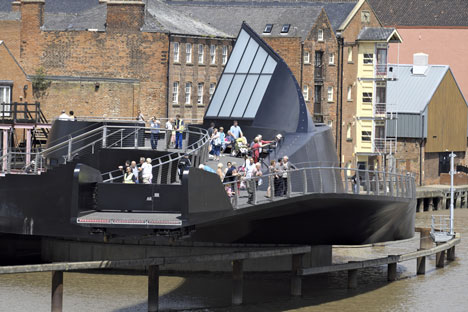
McDowell+Benedetti has worked on several bridges in the UK. Others include a 130-metre long S-shaped footbridge in Yorkshire. See more bridges on Dezeen »
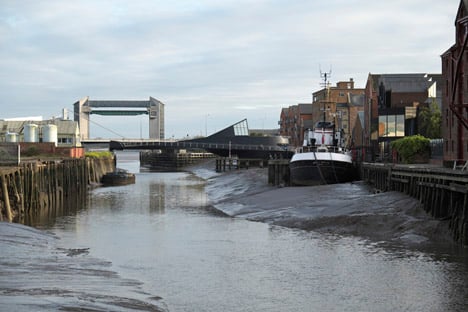
Photography is by Timothy Soar.
Here's some extra information from the architects:
Scale Lane Bridge on River Hull in full swing
An innovative swing bridge over the River Hull has opened to the public, offering pedestrians the unique experience of riding on the bridge as it opens and closes to river traffic, believed to be a world's first.
The black steel bridge has a distinctive robust character and curving form, making it a memorable landmark that is unique to Hull and its industrial and maritime heritage.
The winning entry in an international 3-stage design competition held in 2005, the bridge has been built to the original concept by the competition team, main contractor and M&E engineers Qualter Hall, architects McDowell+Benedetti and structural engineers Alan Baxter Associates. The scheme includes a new landscaped garden and square designed by landscape architects Grontmij with lighting by Sutton Vane Associates and an integrated public artwork by Nayan Kulkarni.
Located in Kingston upon Hull east of Hull city centre the bridge connects Hull's Old Town Conservation Area to the undeveloped industrial landscape of the east bank. Designed as the first stage of a wider masterplan it will unlock the potential of the riverside to promote wider regeneration in the areas east of the city centre. Scale Lane Staith on the west bank has been re-landscaped with a series of stepped gardens leading to a new public square at the threshold of the bridge. The bridge provides a walkable route connecting the Museums Quarter on the west bank to Hull's major attraction The Deep.
The River Hull has a tidal range of almost 7 metres and has exposed mud banks on the west side. The 16 metre diameter drum of the bridge sits snugly into the raised river bed on the west bank and cantilevers 35 metres over the water to the east side. The spine of the bridge arches up and over the river, allowing enough room for smaller boats to pass under without need to operate the bridge, and rotates using an electrical drive mechanism to open the route to river traffic when required.
The bridge's sweeping form creates two generous pedestrian routes, one gently sloping and a shorter stepped walkway. The roof of the drum provides an upper viewing deck with a seamless steel balustrade, which gives the feeling of being on board a docked ocean liner.
The central structural spine of the bridge includes seating areas, creating a variety of places for people to pause on route to relax and enjoy the riverscape views. The spine rises into a back-lit rooflight which provides a marker for the bridge at night.
When activated the mechanical movement of the bridge is sufficiently slow to allow passengers to safely step onto the bridge from the west bank whilst it is rotating.
Artist Nayan Kulkarni has created a public artwork on the bridge, a sonic landscape in which to enjoy the riverscape. When the bridge opening is activated a new sequence of rhythmic bells is triggered which increases in urgency and combines with a pulsing light developed by lighting consultants Sutton Vane Associates. This has a practical purpose in alerting pedestrians to the imminent opening rotation and it heightens the drama of the 'ride'.
At night low level fluorescents integrated into the parapet posts light the profile of the bridge and bring colour and sparkle to the blackened industrial riverscape.
Hull City Council is now actively seeking a tenant to occupy the restaurant space in the bridge hub. Once in place Scale Lane Bridge will become a lively animated public place at all times of the day, fulfilling the design team's intention to create more than just a crossing but a destination in its own right.
At the official opening on 28 June 2013 Councillor Nadine Fudge, Lord Mayor of Hull and Admiral of the Humber, said: "It's an honour to open this unique footbridge on behalf of the city, which links the Old Town to the east banks of Hull. Our Old Town has wonderful museums and attractions and it's great that we're able to add another experience for people to enjoy. Hull's strong maritime history is echoed in the ships bells ringing as the bridge opens and we should be proud that we are continuing to reflect on our heritage."
Jacquie Boulton, Area Manager at the Homes and Communities Agency said: "The opening of this bridge gives the city an excellent opportunity to connect the east bank of the river to the city centre creating opportunities for new economic development. It is great that we have been able to work with our partners to create a bridge that is not only useful to local residents and visitors to the city but is also such a fantastic design."